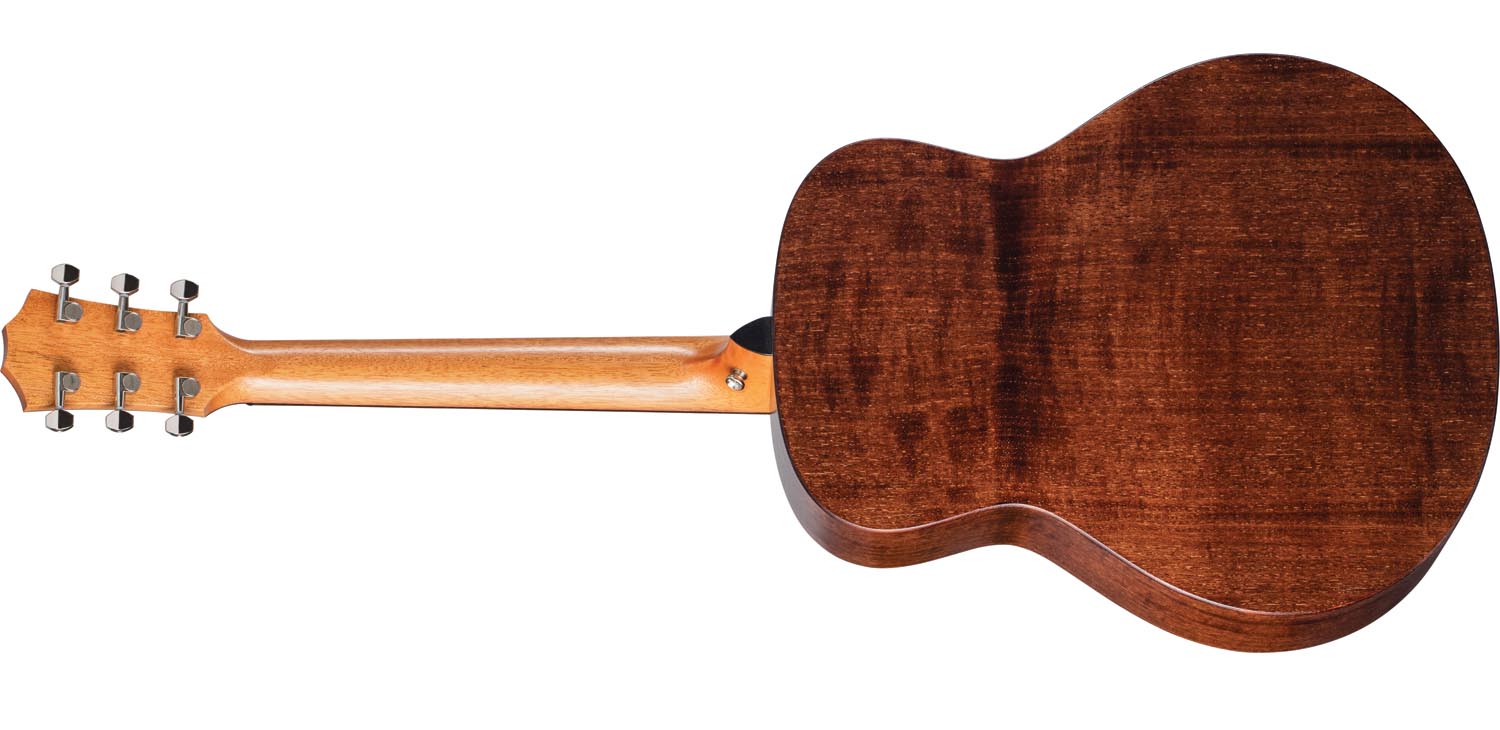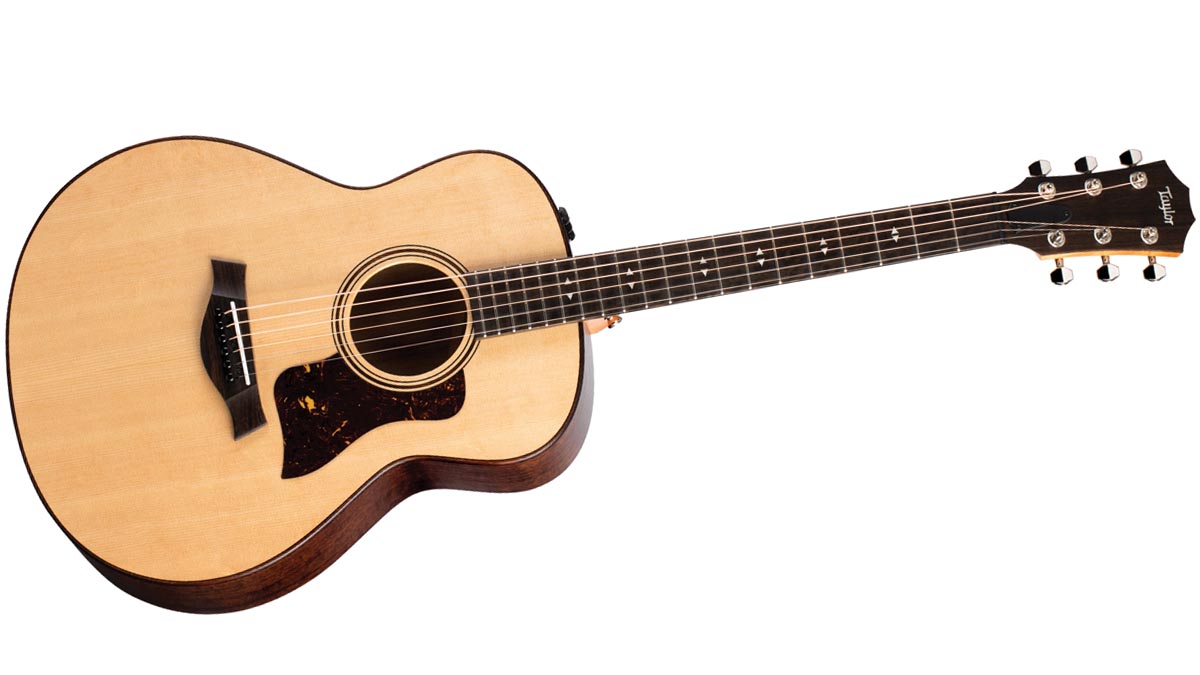GuitarPlayer Verdict
Small but perfectly formed, the GTe Urban Ash is a treat to play, very fingerstyle-friendly, and a triumph for Taylor's C-Class acoustic design.
Pros
- +
Innovative compact design.
- +
Outstanding tone and playability.
Cons
- -
None.
You can trust Guitar Player.
The designation GT has long been applied to sports cars and other things that are agile and speedy, so it’s appropriate that Taylor’s new GT, or Grand Theater, is the sleekest model in the California company’s line.
Size-wise, it sits between the GS Mini and Grand Concert, which is the smallest of the company’s full-size body shapes. Taylor’s reason for creating the ultra-compact GT is simple: Today’s guitarists are drawn to the playability of smaller flattops but don’t want to compromise tone.
I was immediately impressed. It’s one of the easiest playing guitars I’ve ever had my hands on
And this is what prompted design chief Andy Powers to develop a new guitar that combines the inviting playability of a “parlor” instrument with the rich sound of a full-sized guitar.
For this review, we looked at the GTe model, which adds Taylor’s ES2 electronics system. The GT is designed from the ground up for playing comfort, and after taking it out of its brown AeroCase and tuning it up, I was immediately impressed. It’s one of the easiest playing guitars I’ve ever had my hands on.

Weighing a scant 3.7 pounds, it’s light as a feather, yet so dynamic and expressive. It has good sustain and pumps out a surprising amount of volume, all the things one expects from a standard-size steel-string flattop.
Powers developed the GT around several different design concepts. It has the basic body shape of Taylor’s Grand Orchestra, but the proportions are smaller. So while the GT’s 15-inch width at the lower bout is about the same as the Grand Concert’s, its body is shorter – only about 18 1/2 inches long.
The size comparisons continue with the neck measurements, where the GT’s 24 1/8–inch scale length is in the middle between a GS Mini (23 1/2 inches) and a Grand Concert (24 7/8 inches).
As Powers explained, the GT scale is like playing with a capo on the first fret of a 25 1/2–inch-scale guitar, so it has the same string tension as a 25 1/2–inch-scale instrument tuned down a half step. Although the GT comes with .012–.053 strings, it feels like it’s strung with .011s.
Another reason the GT feels so compact and easy to play is that, between its shorter body length and shorter scale (which also slightly compresses the fret spacing), your hands are physically closer together when playing, so the guitar feels more nimble.
Factoring as well into the playability equation is the GT’s 1 23/32–inch neck width, which is right between between 1 11/16 and 1 3/4 inches, making it more comfortable for fretting, especially if you have smaller hands. The GT is constructed of solid urban ash back and sides with a solid spruce top.
Urban ash is a sustainable wood cut from Shamel ash trees slated for removal in city areas around Southern California. Taylor says its tonal qualities rival that of Honduran mahogany, offering a clear, woody sound, with plenty of midrange warmth.
It’s certainly a pleasing-looking wood, with a rippling grain that stands out nicely when bright light hits it. It also feels raw, tactile and woody thanks to the ultra-thin (2.0 mil) Urban Sienna finish.
Much has been made of Taylor’s V-Class bracing, and for good reasons, but the GT uses new C-Class bracing, which Taylor describes as a “cantilevered, asymmetrical design that combines stiffness and flexibility in a way that helps accentuate the lower frequencies to produce a surprisingly warm bass response for such compact dimensions.”
We’re told the bracing borrows some of the functional benefits of V-Class, however, including intonation stability and enhanced volume and sustain, and that’s borne out by the GT’s solid intonation and notable lack of compression when playing it hard.
Cosmetically, the GT is a sweet-looking guitar with a three-ring rosette, tortoise-colored pickguard and black purfling on the top. The acrylic Pinnacle fretboard markers are another classy touch.
Another alternative wood here is eucalyptus, which is used for the fretboard, bridge and headstock overlay. Its striped grain looks similar to ebony, and it has comparable density and weight.
The mahogany neck sits comfortably in the hand, and its soft V shape offers ideal positioning for chording and flat picking
It all adds up to an incredibly fun guitar. The mahogany neck sits comfortably in the hand, and its soft V shape offers ideal positioning for chording and flat picking.
The string spacing and lighter tension is inviting for fingerstyle playing, and the GT is very responsive to the player’s touch, easily steering through softer and louder passages while maintaining consistently sweet and focused tone.
Since our test model was the GTe, it featured Taylor’s Expression System 2 electronics. With the guitar plugged into a Fishman SA-220 system, there was no harshness, and the volume delivered without feedback was impressive.
Bottom line, Taylor’s new GT Urban Ash has a big presence that belies its small size, and the GTe adds on a sweet-sounding electronics package. It’s a natural for trips, but it’s just as worthy as a studio and/or performance instrument thanks to its rich tone and full-bodied soundstage. It’s well deserving of an Editors’ Pick Award.
Specifications
- PRICE: $1,599 street, brown AeroCase included
- NUT WIDTH: 1 23/32”
- NECK: Mahogany
- FRETBOARD: Eucalyptus, 24 1/8” scale, Italian acrylic Pinnacle inlays
- FRETS: 20
- TUNERS: Taylor nickel mini
- BODY: Solid urban-ash back and sides, solid spruce top with C-Class bracing
- BRIDGE: Eucalyptus
- ELECTRONICS: Taylor ES2 with volume, bass and treble controls
- FACTORY STRINGS: Elixir 012–.053
- WEIGHT: 3.7 lbs (as tested)
- BUILT: USA
- CONTACT: Taylor Guitars
- More of the best Taylor guitars

Art Thompson is Senior Editor of Guitar Player magazine. He has authored stories with numerous guitar greats including B.B. King, Prince and Scotty Moore and interviewed gear innovators such as Paul Reed Smith, Randall Smith and Gary Kramer. He also wrote the first book on vintage effects pedals, Stompbox. Art's busy performance schedule with three stylistically diverse groups provides ample opportunity to test-drive new guitars, amps and effects, many of which are featured in the pages of GP.
“I felt myself starting to cry.” Eric Clapton’s 'MTV Unplugged' Martin acoustic returns in two guises. But Slowhand’s affinity for the guitar brand began long before that seminal live performance
"I have a Mercury on the guitar now, which makes me very happy.” Brian May’s new signature Gibson SJ-200 features a subtle tribute to the late Queen singer Freddie Mercury











